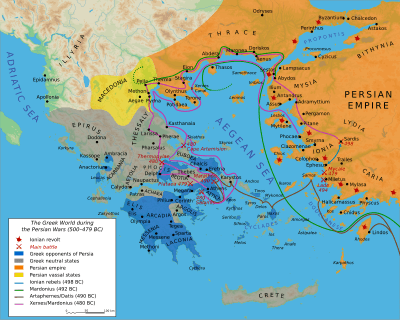Battle of Thermopylae facts for kids
Quick facts for kids Battle of Thermopylae |
|||||||||
|---|---|---|---|---|---|---|---|---|---|
| Part of the Greco-Persian Wars | |||||||||
 The site of the battle today: the road to the right is built on reclaimed land and approximates the 480 BC shoreline. |
|||||||||
|
|||||||||
| Belligerents | |||||||||
| Greek city-states | Persian Empire | ||||||||
| Commanders and leaders | |||||||||
| Leonidas I †, Demophilus † |
Xerxes I of Persia, Mardonius, Hydarnes |
||||||||
| Strength | |||||||||
| Total 5,200+ (Herodotus) 7,400+ (Diodorus) 11,200 (Pausanias) |
Total 2,600,000 (Herodotus) ~800,000 (Ctesias) 70,000–300,000 (modern estimates) |
||||||||
| Casualties and losses | |||||||||
| 1,000 to 4,000 (Herodotus) | ~20,000 (Herodotus) | ||||||||

The Battle of Thermopylae was a famous fight in 480 BC. It was part of the second Persian invasion of Greece. This battle happened between an alliance of Greek city-states and the huge Persian Empire. The Greek forces were led by Sparta. The Persian army was led by King Xerxes I. The battle took place at a narrow mountain pass called Thermopylae. It lasted for three days. At the same time, a naval battle was happening nearby at Artemisium.
Contents
Why Did the Battle of Thermopylae Happen?
The Persian invasion was a delayed response to an earlier defeat. Around 500 BC, some Greeks called the Ionians lived on the western coast of Asia Minor. They rebelled against the Persian King Darius. After six years, the rebellion was stopped. In 490 BC, the Persians sailed to punish Athens. Athens had helped the Ionians. This first war ended when Athens won the Battle of Marathon. King Xerxes, Darius's son, then planned a much larger invasion to conquer all of Greece.
How Did the Greeks Prepare for Battle?
Xerxes gathered a massive army and navy. He wanted to take over all of Greece. The Athenian general Themistocles had a smart idea. He suggested that the Greek allies should block the Persian army. They would do this at the narrow pass of Thermopylae. At the same time, the Greek navy would block the Persian navy. This would happen at the Straits of Artemisium.
About 7,000 Greek soldiers marched north. They went to block the pass in the summer of 480 BC. The huge Persian army arrived at the pass in late August or early September.
What Happened During the Battle?
The Greeks were greatly outnumbered. Yet, they held off the Persians for seven days. Three of those days were full of fighting. In the end, a small group of Greek soldiers made a famous last stand.
For two full days, the small Greek force held their ground. They were led by King Leonidas I of Sparta. They blocked the only road the massive Persian army could use. But after the second day, a local person named Ephialtes betrayed the Greeks. He showed the Persians a secret path. This path led behind the Greek lines.
King Leonidas knew his army was about to be surrounded. He sent most of the Greek army away to safety. He stayed behind to protect their retreat. With him were 300 Spartans, 700 Thespians, and 400 Thebans. A few hundred others also stayed. Most of these brave soldiers were killed.
The pass at Thermopylae was then open to the Persian army. The ancient historian Herodotus said the Persians lost up to 20,000 soldiers. The Greek rearguard, the soldiers who stayed behind, were nearly all killed. They likely lost about 2,000 men in total, including those from the first two days.
After the battle at Thermopylae, the Greek navy at Artemisium heard the news. Their plan needed both Thermopylae and Artemisium to be held. Because of their losses and the defeat on land, the Greek navy decided to leave. They sailed to Salamis. The Persians then captured Athens, which had been emptied. During the naval battle, the Greek navy, thanks to Themistocles, tricked the Persians. They lured them into a narrow area and destroyed at least 200 Persian warships.
The Persian fleet wanted a big win against the Greek ships. They attacked, but the Greeks defeated them at the Battle of Salamis in late 480 BC. King Xerxes feared being trapped in Europe. So, he took much of his army and went back to Asia. He left Mardonius to finish conquering Greece. However, the next year, a Greek army completely defeated the Persians. This happened at the Battle of Plataea. This battle finally ended the Persian invasion.
Both old and new writers have used the Battle of Thermopylae as an example. It shows the power of a patriotic army defending its home. The way the defenders fought at Thermopylae also shows the benefits of good training, equipment, and using the land wisely. It has become a symbol of courage against huge odds.
Related pages
- The 300 Spartans (movie)
Images for kids
-
The site of the battle today. Mount Kallidromon on the left, and the wide coastal plain formed by accretion of fluvial deposits over the centuries; the road to the right approximates the 480 BC shoreline.
-
5th century hoplite.
-
Contemporary depictions: probable Spartan hoplite (Vix crater, c.500 BC), and Scythian warrior of the Achaemenid army (tomb of Xerxes I, c.480 BC), at the time of the Second Persian invasion of Greece (480–479 BC).
-
The Capture of the Acropolis and the destruction of Athens by the Achaemenids, following the battle of Thermopylae.
-
Hidush (Indian soldier of the Achaemenid army), circa 480 BC. Xerxes I tomb. Herodotus explained that Indians participated on the Second Persian invasion of Greece.
-
Epitaph with Simonides' epigram
See also
 In Spanish: Batalla de las Termópilas para niños
In Spanish: Batalla de las Termópilas para niños

















